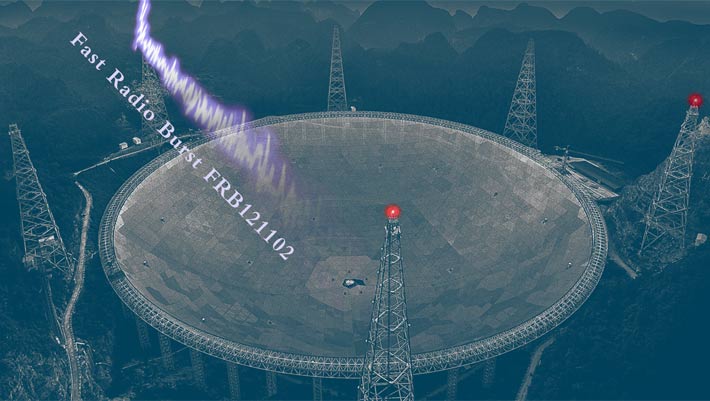
Astronomers Detect 1,652 Fast Radio Bursts from Source in Distant Dwarf Galaxy
Astronomers using the new Five-hundred-meter Aperture Spherical radio Telescope (FAST) have detected 1,652 independent burst events from the FRB 121102 source — which is located some 3 billion light-years away in the constellation of Auriga — over a period of only 47 days.Li et al. observed 1,652 fast radio bursts detected from a source in deep space. Image credit: National Astronomical Observatories, Chinese Academy of Sciences.Since fast radio bursts (FRBs) were first discovered in 2007, astronomers worldwide have turned to powerful radio telescopes like FAST to trace the bursts and to look for clues on where they come from and how theyre produced.The source that powers most FRBs is widely believed to be magnetars, incredibly dense neutron stars that possess the strongest magnetic fields in the Universe.And while scientists are gaining greater clarity on what produces FRBs, the exact location of where they occur is still a mystery.There are two active models for where FRBs come from, said Dr. Bing Zhang, an astronomer in the Department of Physics and Astronomy at the University of Nevada.One could be that they come from magnetospheres, or within a magnetars strong magnetic field. Another theory is that FRBs form from relativistic shocks outside the magnetosphere traveling at the speed of light.The new results pose great challenges to the latter model, he said.The bursts are too frequent and — given that this episode alone amounts to 3.8% of the energy available from a magnetar — it adds up to too much energy for the second model to work.FRB 121102 was first detected in 2012 by astronomers using Arecibo Observatorys radio telescope.Two years later, they found that FRB 121102 was a repeating source, and a year later, they located it in a dwarf galaxy some 3 billion light-years away.From this source, 1,652 fast radio bursts are a startling number, said Dr. Shami Chatterjee, an astronomer in the Cornell Center for Astrophysics and Planetary Science and the Department of Astronomy at Cornell University.Until now, astronomers had been talking about a handful of bursts — a few, then maybe 10 and perhaps 25. But now were talking about over 1,600 bursts over 47 days. Thats really dramatic.The bursts were measured by FAST within a total of 59.5 hours over 47 days from August 29 to October 29, 2019.During its most active phase, FRB 121102 included 122 bursts measured within a one-hour period, the highest repeat rate ever observed for any FRB, said Dr. Pei Wang, an astronomer with the National Astronomical Observatories at the Chinese Academy of Sciences.Whatever is producing those bursts, its got to be unimaginably energetic, Dr. Chatterjee noted.Having a large number of bursts on a given day, we still cannot identify its period, said Professor James Cordes, an astronomer in the Cornell Center for Astrophysics and Planetary Science and the Department of Astronomy at Cornell University.We know that a spinning object like a pulsar — which has a lighthouse-like beam — has a specific period. But this FRB is more of a puzzle.There might be a neutron star involved, but we have no hint of a periodicity. It deepens the mystery.A paper on the findings was published in the journal Nature._____D. Li et al. 2021. A bimodal burst energy distribution of a repeating fast radio burst source. Nature 598, 267-271; doi: 10.1038/s41586-021-03878-5
……Space
Comments
Leave a comment in Nestia App